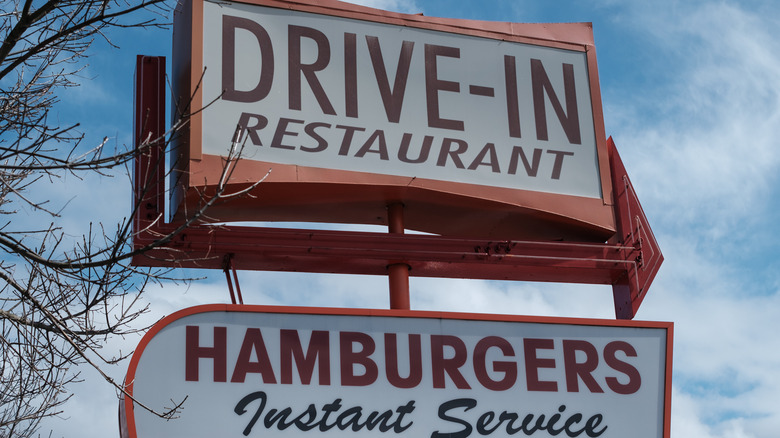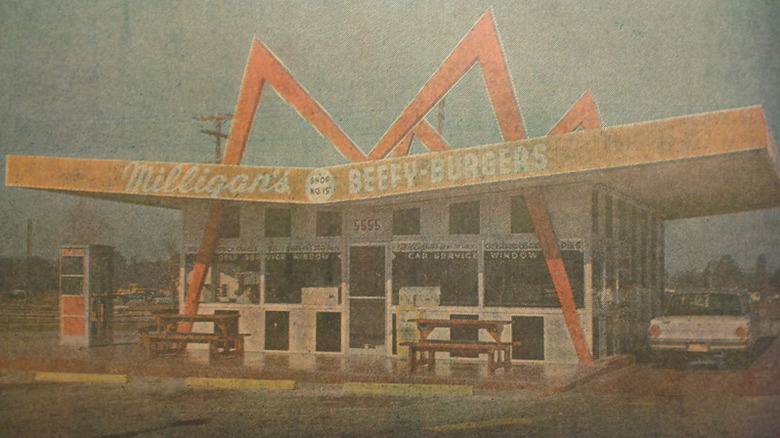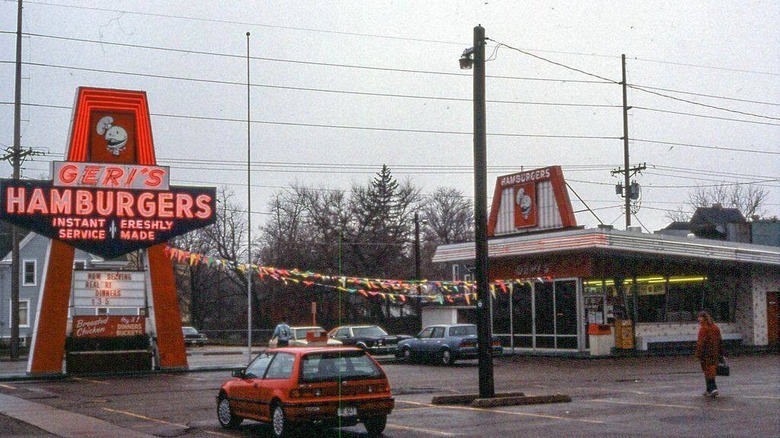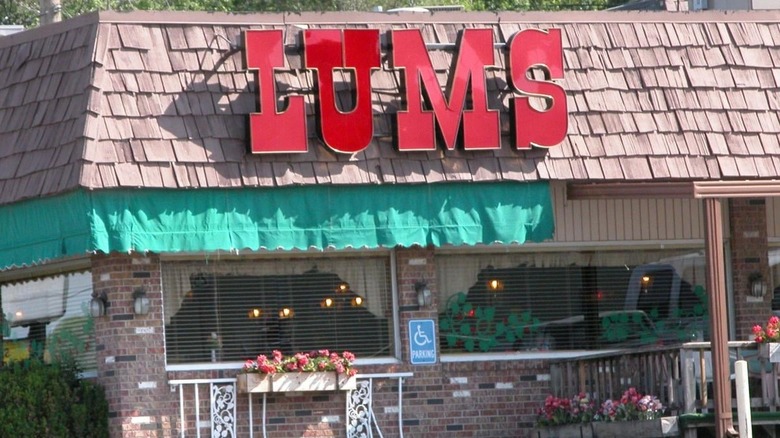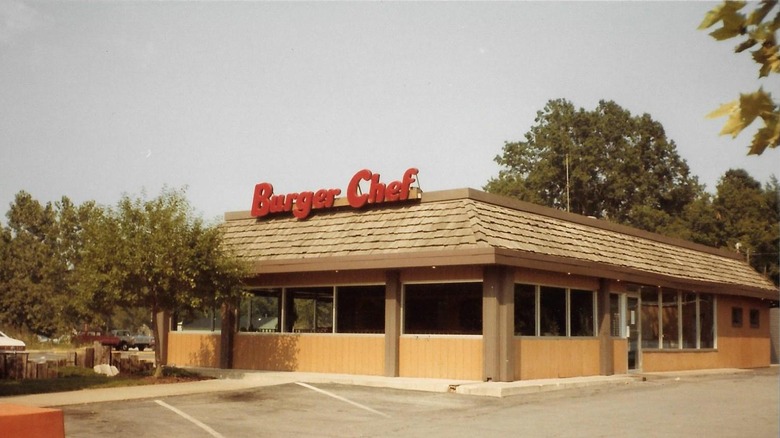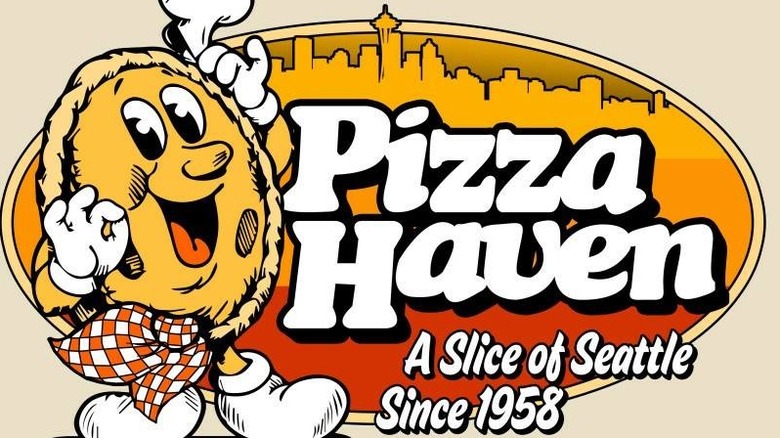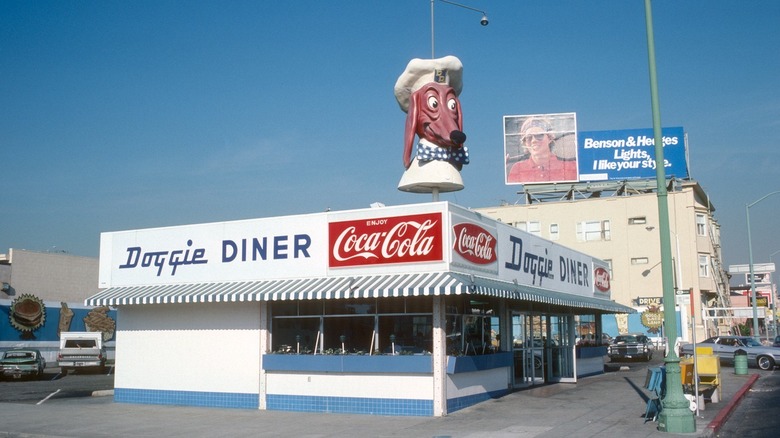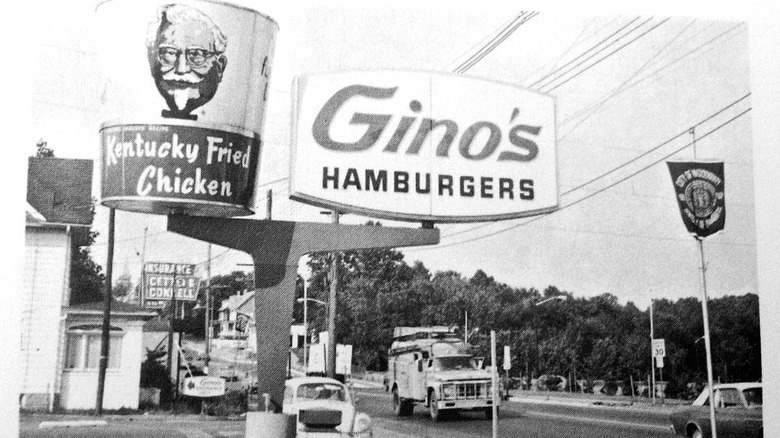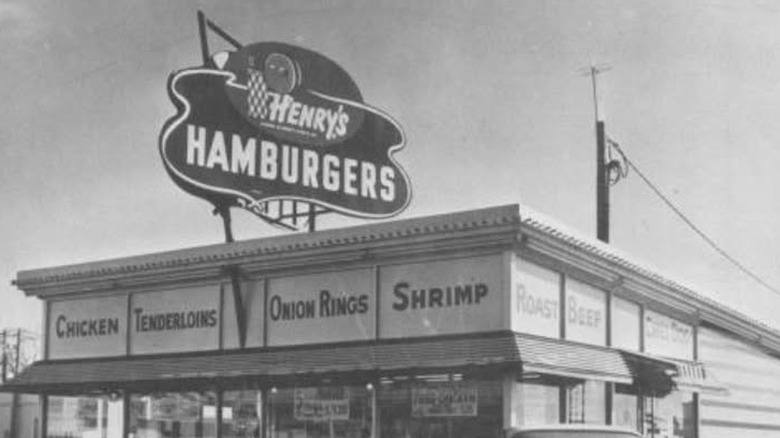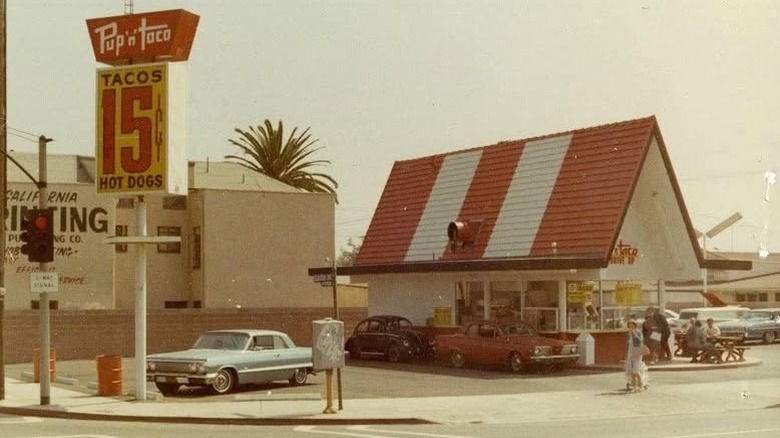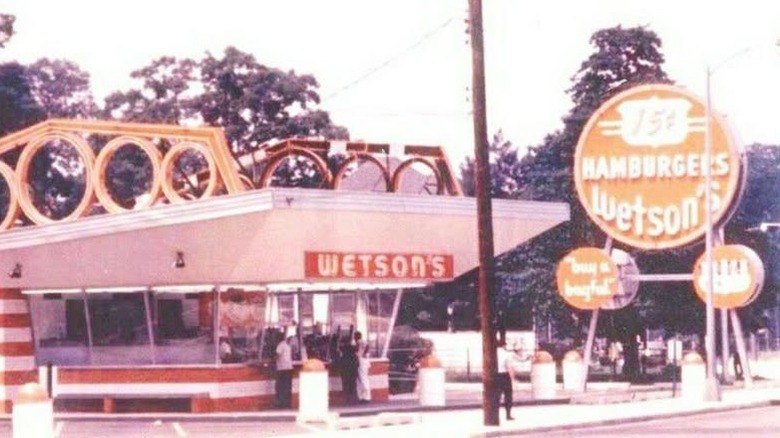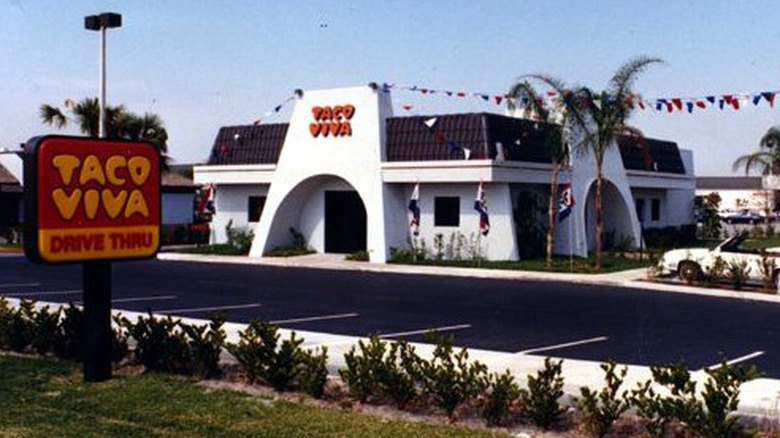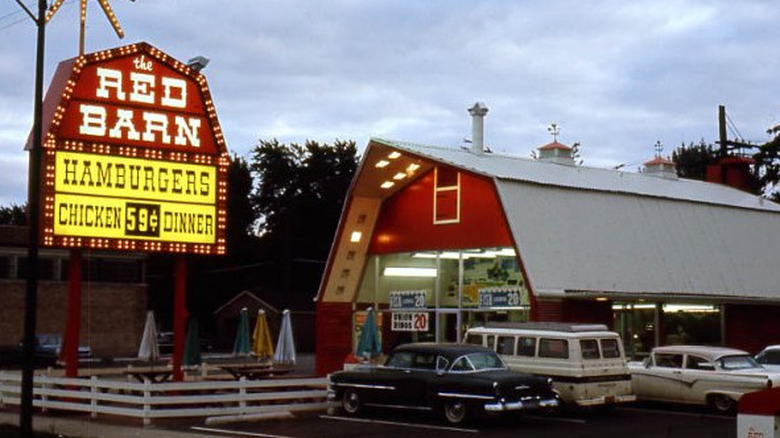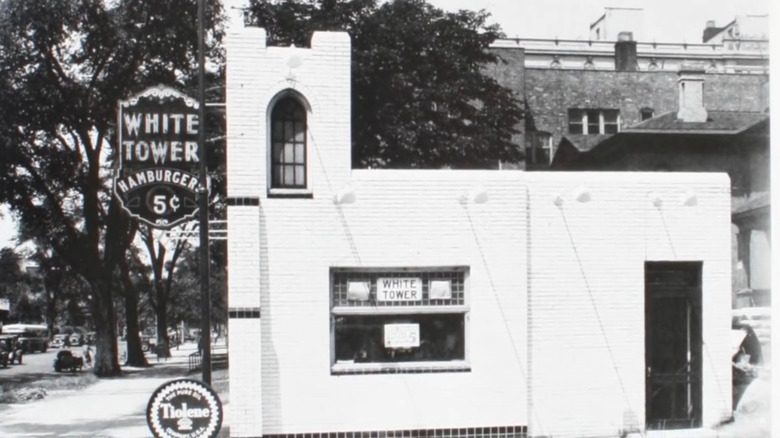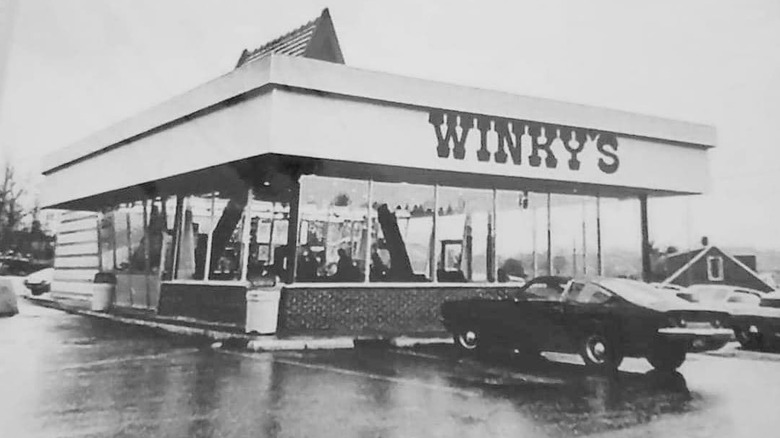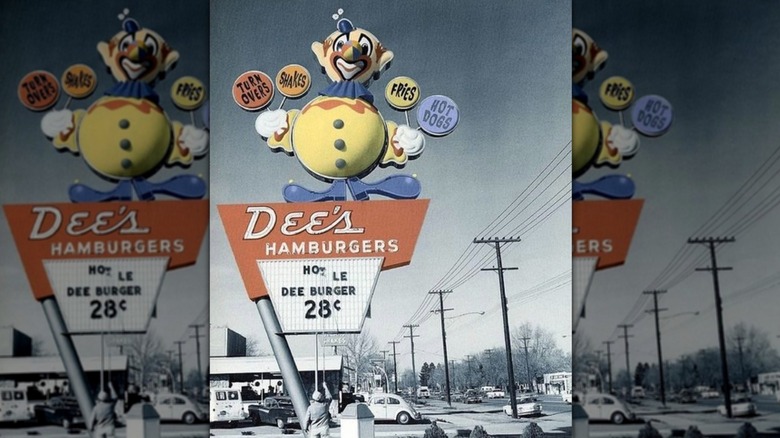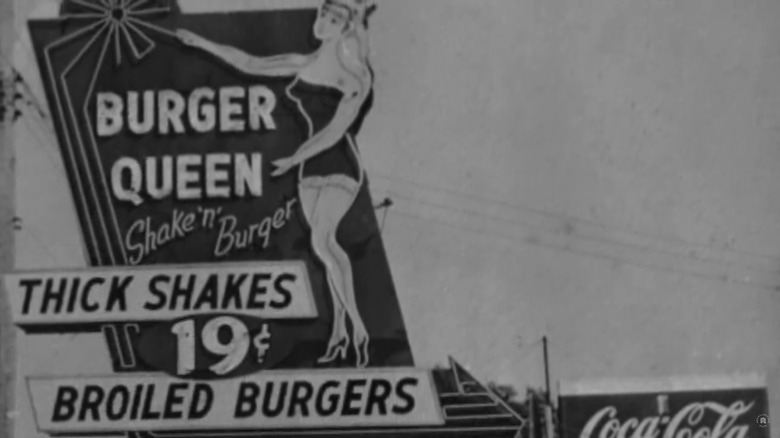16 Discontinued Fast Food Chains We Wish Still Existed
You can't escape fast food. Between storefronts lining the streets, billboards, and advertisements, living in modern society is kind of like getting hamburgers and fries shoved in your face every 15 to 20 minutes. Some people are happy for this to be the case, but even if you're not a fast food person, you can probably list five or six burger-and-fry restaurants off the top of your head. However, those household names are the champions who have emerged from the greasy arena with money in their pockets and locations in every city.
In fact, there are a ton of other fast food restaurants that didn't make the cut. The early-mid-20th century saw the invention of the modern fast food joint, and the following boom was an absolute circus of competitive innovation with businesses developing faster, more efficient techniques to get all that good stuff into the bellies of hard-working Americans. Hot dogs were weirdly popular among some of these older businesses, but the hamburger has always been a mainstay. Unfortunately for most of these restaurants, their presence on the market was as temporary as the fast food hotdog. Here are classic fast food franchises that we wish were still around.
Milligan's Beefy Burgers
Jacksonville Florida's claim to burger fame began in 1942 with its answer to popular fast food franchises like Krystal and White Castle. Jacksonville had Milligan's Beefy Burgers, and during the first year, Milligan's would sell no fewer than 450,000 burgers to hungry Floridians. Proprietor Elmer Milligan had two locations by 1950, and just 14 years after that, he owned 16 locations and sold about 5,000,000 burgers every year.
Jacksonville remembers this chain as a part of its history, reflecting on things like the incredible value of a good old fashioned sack of Milligan's burgers, which used to run you $1 for 12 burgers. Now that's some incredible value, even when you factor inflation into the mix. Elmer Milligan eventually passed away, and his son took over as president. But by 1974, the massively competitive fast food industry had seen to it that Milligan's could no longer persist.
Geri's Hamburgers
Geri's opened its doors in 1960, imitating the relatively new McDonald's drive-in/walk-up model, Geri's offered a modest menu of burgers, fries, milkshakes, and a few soft drinks. Nothing too fancy — just the essentials. Over the next two years, it opened up two new locations. By 1972, it had declared it would be going nationwide, although that sadly never happened. Like so many other fast food chains, McDonald's was cornering the market and hurting the smaller chains that struggled to keep abreast of their major competition.
By 1981, Geri's had decided it was time to close down the franchise, leaving just a few locations open to run independently. But without franchise support, these too would eventually fade into burger history. Some Geri's aficionados still remember its $0.20 hamburgers, and how easy it was to grab a sack full of them and keep well fed for the rest of the day.
Lum's
In 1956, brothers Stuart and Clifford Perlman bought a 16-seat hotdog stand in Miami, and over time, it would transform into the beloved chain known as Lum's. Today, it's virtually unheard of, but back in the day, it boasted 450 locations, so it was kind of a big deal. Unlike so many other fast food chains, Lum's signature offering was not a hamburger, but a beer-steamed hotdog, which sounds amazing.
Lum's was unusually classy for a fast food restaurant, and as time went on, the Perlman brothers sold the franchise to one John Brown, who expanded the menu to include one of Lum's most famous offerings: the Ollieburger. This was not Brown's own invention. Apparently, he discovered this burger at a different Miami locatio (a sandwich shop) and he loved it so much that he paid its creator $1 million for the secret recipe. Lum's had kind of an Arby's vibe, offering everything from roast beef sandwiches to butterfly shrimp. It also served beer, which is pretty cool for a fast food place — and not the kind of thing you see these days. Lum's eventually found itself struggling, and the franchise was done for by the 1980s.
Burger Chef
Burger Chef was no joke in its day. Once upon a time, in the 1950s, it was the main competitor of McDonald's, and the Burger Chef franchise had 2,500 storefronts nationwide. It was actually the first fast food restaurant to do the whole drive-thru thing, and it invented the concept of the fast food kid's meal as we know it today. The flame-broiled patty that Burger King is known for today? That was pioneered by Burger Chef. Each restaurant had its technique down pat: The storefronts could prepare 2,000 cooked burgers per hour, which is unbelievable. The wait time between ordering and receiving your burger was about 20 seconds. It's no wonder these guys were second only to McDonald's.
Unfortunately, the restaurant chain began to decline after a tragic incident in the 1970s: Several employees were kidnapped from one of the restaurants, and they were found murdered. Due to the bad publicity from this, plus alleged mismanagement, Burger Chef was sold to Hardee's in 1982. At that time, it was worth $44 million, and the final Burger Chef location was closed down in 1996.
Pizza Haven
Founded in 1958, Pizza Haven quickly became a Seattle classic. It was actually one of the first restaurants to use the phone system, in which people would order pizzas remotely for delivery. It first showed up in Seattle's University District, and it quickly became a Pacific Northwest favorite. It would eventually expand into Europe and the Middle East, and to this day, fans reflect on how much they loved Pizza Haven. One Redditor went as far as to say that "it was the best in its day."
Unfortunately for Pizza Haven, the big boys proved too much to handle. Domino's and Pizza Hut were just too big and powerful in the end. This seems to be the way of things for fast food restaurants. You either blow up and become a big name, or else the other, bigger players swallow you up. We'll miss Pizza Haven's mascot, the pale yellow pizza guy with the cute little handkerchief that floats mysteriously over his lower crust.
Doggie Diner
San Francisco's famous for all kinds of things, but one of these is the invention of the Doggie Diner mascot, a weird little mutt with wrinkly red skin and a narrow snout. Whether you think he's cute or creepy, the wiener dog in the white chef's hat was a symbol of awesome fast food from 1948 until 1986. Doggie Diner showed up before McDonald's even hit the scene, so it was a pretty big deal for San Franciscans. Before 1969, Doggie Diner had 30 locations, and at its peak, it served almost 6,000 pounds of burgers, dogs, and fries every week (plus 35,000 gallons of soda). It also sold milkshakes and pastrami sandwiches.
The franchise has been so well missed that there is talk of it reopening sometime soon. They plan on resurrecting the memorable old mascot, and the folks behind the revival have apparently purchased a 10-foot-tall fiberglass dog head, which was itself built about 50 years ago.
Gino's Hamburgers
Built from the ground up by NFL defensive end Gino Marchetti, Gino's Hamburgers was a successful chain that focused much of its efforts on the Eastern Seaboard, eventually growing to 359 restaurant locations. It served something called the "Gino Giant," which is considered by some to be a precursor to the Big Mac from McDonald's.
It also had a deal called "Meal for Five," which was a family offering intended to feed multiple people for the amazing price of $1.75. Burgers were $0.10, and milkshakes were $0.20. Gino's was part of the golden age of fast food that provided lots of grub at very reasonable prices, and the franchise did very well for itself. Gino's had this all-American vibe that made it perfect for families grabbing a bite together after sporting events, but the world of fast food is brutal, and Gino's eventually found itself getting benched.
Henry's Hamburgers
Henry's Hamburgers actually got its start as an ice cream business called Bresler's Ice Cream. In 1954, the company leaders wanted to promote its milkshakes without disrupting the solid ice cream franchise that they already had going. But the fast food industry was taking off aggressively, and the company knew they had to get in on the action. Thus, Henry's Hamburgers was born, named after Henry Bresler, one of the founding brothers of the Bresler's business.
By 1956, Chicago alone was home to thirty-five Henry's locations, and across the U.S., there were more than 200 of them. Henry's was well known for its popular slogan, "Aren't you hungry for a Henry's?" The brand offered $0.12 burgers, once again exemplifying the beautiful food-for-all mentality behind so many of these defunct old fast food chains. Henry's began to falter in the 1970s, maybe due to a general failure to compete with evolving fast food brands. For instance, it never adopted the drive-thru window method, and it didn't have anything like the substantial ad campaigns put out by the big-name franchises like Burger King. Luckily, there is still one location remaining today, so you can check out the old-school nostalgia for yourself.
Pup 'n' Taco
Pup 'n' Taco was an interesting restaurant — kind of like an early hybrid of McDonald's and Taco Bell. In fact, Taco Bell eventually bought the company out in 1984. Before then, Pup 'n' Taco was known for its tacos, burgers, pastrami, and hot dogs. One fondly remembered Pup 'n' Taco ad features a little hotdog bullfighter goading a hotdog into running at him. The ad reminds us that this is a happy little eatery where tacos are only $0.29, which is a dreamlike statement from a slice of too-good-to-be-true Americana.
Pup 'n' Taco showed up in 1956, and it held strong until 1984, which is when Taco Bell finally stepped in. Nothing against T-Bell, but where else can you get a taco/hotdog/burger combo anymore? Fans still reflect fondly on things like the Pup 'n' Taco chili dog and the cherry slush. Maybe someday, a brave new franchise will once again bridge the gap between tacos and burgers.
Wetson's
Wetson's began in 1959 as yet another burgers-and-fries shop with a colorful walk-up window for easy ordering to eat in the car or on the go. Herb Wetanson, who co-founded the restaurant with his brother Erol, had visited a McDonald's for the first time when he went to California. After that, he felt inspired to kick off his own fast food franchise, and Wetson's was born. Starting things off with a simple hamburger stand, he and Erol installed it in a coffee shop. Only $0.15 got you a hamburger, and $0.10 got you a little container of fries, so pretty much the standard for these older fast food places.
In addition to the usual fare, Wetson's also sold cake and tuna fish sandwiches, which is not something you see at most fast food restaurants. There's no reason a place today couldn't venture outside the normal bounds and throw a tuna sandwich and a slice of cake on the menu. But fast food-type menus are now so well established that maybe it wouldn't work. The days of experimentation are over — Wetson's and its chocolate cake disappeared in 1975 to merge with Nathan's.
Taco Viva
Taco Viva showed up on the scene in Fort Lauderdale, Florida, 1968. Mexican cuisine was relatively new to Florida, so Taco Viva was one of the first places to bring that Taco Bell vibe to the Floridian diet. One Redditor remembered his first experience dining in for Mexican cuisine, saying, "I found it superior to Taco Bell. No comparison actually."
This is yet another discontinued franchise that did surprisingly well in its time. Taco Viva expanded until it had 85 locations across 11 states. Taco Viva actually had a great sense of humor, too – one of the most famous ads sees a Clint Eastwood lookalike sitting down at a Taco Viva in the middle of the desert. His companion ends up stranded without a horse, which "Eastwood" points out is because "ya didn't say Viva." The franchise's tagline was, "When you say Taco, say Viva!" Figuratively speaking, the chain itself ended up alone in the desert when they were bought out by Miami Subs in 1989.
Red Barn
Red Barn showed up in Rochester, New York in the 1960s. It was never a truly serious competitor to places like McDonald's or Burger King, but as a smaller chain, its charm and tasty grub reached the hearts of many people during America's fast food boom. It basically supplied all the usual goodies like cheeseburgers and fried chicken. Red Barn was one of the earlier franchises to offer salads, although whether folks went here for their salad fix is anyone's guess.
Charmingly, Red Barn restaurants were all made in the image of classic red farm structures, and its food had fun, colorful names like the "Barn Buster" or the "Big Barney." At the height of its popularity, Red Barn had somewhere between 300 to 400 locations across 19 states — it even had locations in Australia and Canada. But Red Barn was not to be forever — in the 1960s, United Servomation bought it out, and the business basically flopped after that. Red Barn's final leases expired in 1988, and that was that.
White Tower
Founded in Milwaukee, Wisconsin in 1926, White Tower was renowned for its fort-like architecture, channeling the aesthetic of a very small feudal lord's adorable fief. It was thought of as a copycat, since White Castle, the more famous franchise you were probably thinking of, beat them to the punch and started five years earlier in 1921.
Old-fashioned fast food restaurants are famously cheaper than its modern counterparts, but White Tower might have outdone them all by selling $0.05 hamburgers during The Great Depression. White Tower's first good decision was to base its initial location near Marquette University, which made it a very convenient option for hungry students. Perhaps due to this strong foundation, White Tower could boast 230 locations by the time the 1950s rolled around. White Tower famously hired young women it called "Towerettes," who wore nurse outfits as an indicator of clean, hygienic eating conditions. The final White Tower location closed up shop in 1978, and, today, it feels as antiquated as the castles it used to mimic.
Winky's
Winky's showed up a little late to the party in 1962, around the time fast food was becoming the American Way. It made up for lost time, though, spreading into two other states with a combined total of 40 locations. It sold milkshakes, just like so many of its competitors, only its version was called the "Winkyshake." This does not sound particularly edible, but it was apparently pretty popular. The brand also had a burger called the "Big Wink." For this, and for the unusual ad campaign, Winky's may be the most eccentric restaurant chain on our list. Some of the ads featured a spastically agitated orange muppet that stole hamburgers from children on a game show. Pretty wild stuff for the 1970s.
Fans love to reminisce about the large portion sizes at Winky's, and some of them even try to recreate the famous burgers now that they're no longer available. But by the mid-1980s, Winky's and its weird muppet guy had winked out of existence.
Dee's Hamburgers
Utah is the home of Dee's Hamburgers, and this franchise laid claim to the great state long before Wendy's or any other fast food chain had set up shop there. Dee's used to have 50 drive-ins, and for whatever reason, it even dropped a sibling franchise in South Africa, which was the first of its kind there. There's information aplenty on Dee's and its founder, Dee Anderson, because he wrote an autobiography called "A Boy from Ephraim."
Briefly, Anderson was inspired by a trip to Long Beach, California, where he experienced his first drive-in. It was a year later that he opened the first Dee's location — that would be 1953. Dee's sold all the regular goodies like burgers, fries, and hotdogs. Dee's prided itself on serving customers rapidly, but it was later in life, as he was writing his autobiography, that Anderson speculated about opening up a smaller operation to focus on something he felt the fast food industry had lost: slow-prepared homestyle food. Anderson's son would go on to take over the franchise, which he sold to Hardee's in the 1980s.
Burger Queen
For whatever reason, Florida seems to be a really common place for old-fashioned, defunct fast food restaurants to pop up. Yet another Floridian restaurant was Burger Queen, the lesser known spouse of the King himself. Burger Queen showed up in 1956, and for five years, it continued growing until it was sold to a pair of business partners from Kentucky. The new guys took Burger Queen international, adding things like seafood and salad to the standard fast food offerings.
The name was fairly unfortunate though, and it cost Burger Queen a lot of time and energy to engage in legal battles with not only Burger King but Dairy Queen. Eventually, it changed its name altogether and became "Druther's." Kentucky is now home to the last remaining Druther's restaurant. The business became a franchisee of Dairy Queen, and a lot of Dairy Queen's modern breakfast menu was actually derived from good old Burger Queen.

